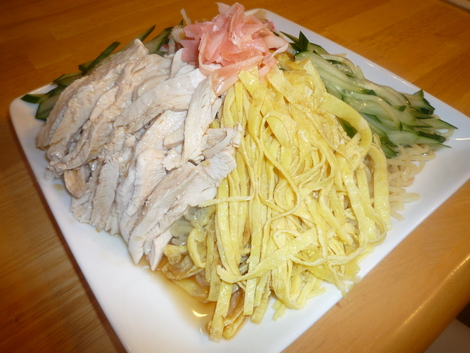 Hiyashi Chuka is one of my absolute favorite things to eat. I will never forget the first time I had it. My grandmother and grandfather had just arrived from Japan and were unpacking their large bulky suit cases in the kitchen because, of course, 1/3 of their luggage was food from Japan. Back then, it was difficult to find fresh ramen noodles, even at the Japanese grocery stores, so my grandmother brought it over to make hiyashi chuka. I was a little perplexed as to why my mom was excited over this, but I had grown accustomed to my mother’s very animated reaction to food from a young age, so I just chalked it up to mom being mom.
Hiyashi Chuka is one of my absolute favorite things to eat. I will never forget the first time I had it. My grandmother and grandfather had just arrived from Japan and were unpacking their large bulky suit cases in the kitchen because, of course, 1/3 of their luggage was food from Japan. Back then, it was difficult to find fresh ramen noodles, even at the Japanese grocery stores, so my grandmother brought it over to make hiyashi chuka. I was a little perplexed as to why my mom was excited over this, but I had grown accustomed to my mother’s very animated reaction to food from a young age, so I just chalked it up to mom being mom.
I hung out in the kitchen while my mother and grandmother figured out an acceptable sauce to go with the hiyashi chuka. When it was finally done and ready to eat, I was even more confused why it was on a plate for one, and not served hot with soup. It was promptly explained to me that hiyashi chuka is a summer dish and is served cold. My first impression was how vibrant and colorful the plate was. It’s essentially a noodle salad with lots of ingredients. To this day, I remember how sad I was when I was done eating it and I found out that my grandmother only brought enough to make it once. And on top of that, my mom told me that we couldn’t eat it again until we went back to Japan.
Today, you can find hiyashi chuka ramen packages readily in Japanese grocery stores in the US where you can choose from a variety of tare (dressing/sauces). There’s usually soy sauce, miso and goma flavors. You can also find uncooked ramen without the sauces, which are a lot cheaper, and you can make the tare yourself.
It’s already fall now but we’ve been experiencing a heat wave, so as a last hurrah to summer, I thought I would include one of my all time favorite recipes. Hiyashi chuka is one of those seasonal menu items that leave the menus as soon as it’s October in Japan. I’m not sure why but I’m always sad when this happens. Maybe I still associate it with the disappointment I felt as a child at being told that I couldn’t eat something because it was 5000 miles away. I think I’m also just scared of not being able to eat my favorite foods. I know, it’s a strange fear to have but we all have weird fears right?
Ingredients (Servings 2)
Tare sauce (see below)
1 kyuri
2 sticks of kanikama (imitation crab meat)
1 cooked chicken breast cut into strips
kinshi tamago (This recipe is enough for 2)
1 tablespoon of sushi gari (ginger) for garnish
1 package usually come with 3 packs of ramen noodles
Tare Sauce (Soy Sauce/Sesame flavor) Ingredients
3 tbsp. dashijiru
3 tbsp. mirin
3 tbsp. rice vinegar
1 tbsp. + 1 tsp. soy sauce
2 tbsp. sugar
2 tsp. sesame seed oil
Directions
1) Start by making the sauce first because you want it to chill. Mix the dashijiru, mirin, rice vinegar and sugar into a pot and allow the sugar to dissolve and the pot to come to a light simmer. Turn off the stove immediately.
*This allows the vinegar to mellow out. I find that most tare are very strong but I prefer mine to be more like tare and less like salad dressing.
2) Add the soy sauce and sesame seed oil. Let cool and refrigerate. * Optional: Once it’s cool, add a splash of ginger juice from the sushi gari (pickled ginger).
3) Next, prep the toppings. Boil a chicken breast until cooked all the way through, no more than 5-7 minutes. If it’s a thick chicken breast butterfly before cooking.Slice into strips.
4) Cut kyuri julienne.
The cucumber gives this dish crunch so I like to prep enough kyuri to have two servings per dish. (See Build-a-meal photo below)
5) Next make the kinshi tamago. (See directions on how to make it here)
6) Pull apart the kanikama into strips. (1 per person)
7) Pull the noodles out of the bags and separate them, otherwise you’ll have three blobs of noodles. Three packages is just enough for 2 servings. 1 package is not enough for me, plus all of this work is not worth it to do portion control. Do that when you eat something else.
8) Boil the noodles. You don’t want to do this step first because the noodles will “nobiru” or lose their chewiness. Follow the directions on your package but it should be a few minutes.
9) Once the noodles are drained. Use ice to make sure that they are cooled all the way. Put them in a small strainer and strain as much water as you can out of the noodles so that the water doesn’t dilute the sauce.
10) Plate with the toppings around it a circle with the topping all facing the same direction. I like to break up the kyuri so you get some green going around twice. Garnish with gari and serve with the tare on the side.
Add the vinegar, dashijiru, mirin and sugar to the pot and let it come to a simmer and turn off the stove. This will mellow out the vinegar and make it just right.
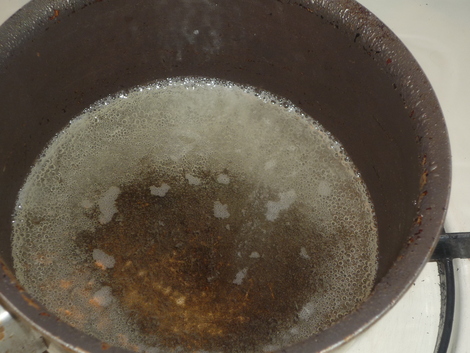
Add the soy sauce and sesame seed oil. Put in a container and refrigerate until cold. Add a splash of ginger juice from the gari (pickled ginger) for a hint of ginger flavor or garnish with gari.
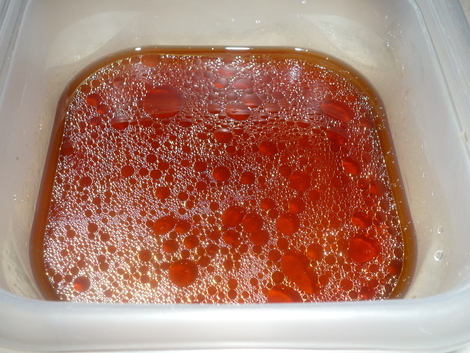
Pull apart the kanikama into strips. 1 kanikama should be enough for 1 person. If you want to get fancy you can use real crab but I’m not a big fan of crab. It’s a long story…
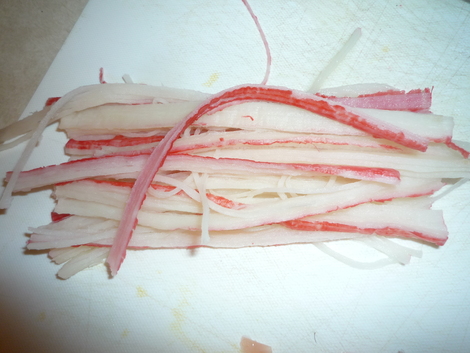
Prepare the kinshi tamago and cut julienne as well. See above link for directions.
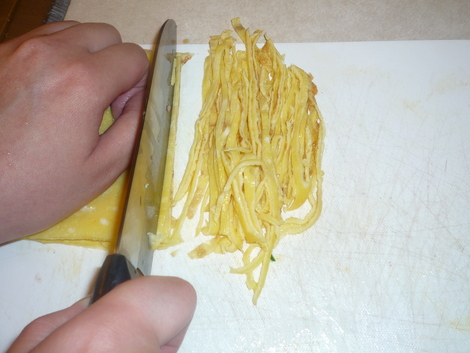
Hiyashi Chuka comes in packages like this. This one comes with a gomadare (sesame seed sauce.)
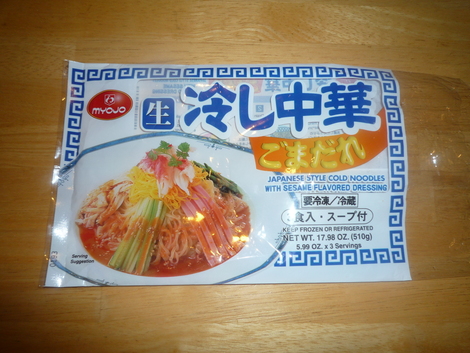
There are usually three servings wrapped into individual packages but it’s more like two.
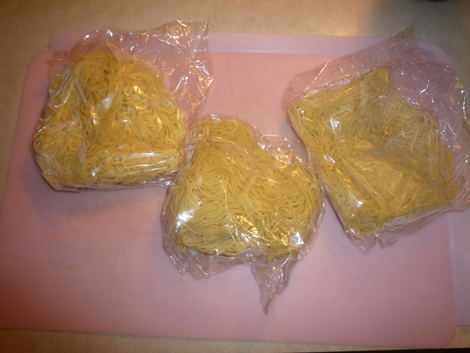
Separate the noodles so that they don’t stick when you put them into the boiling water. Trust me, it’s a necessary step.
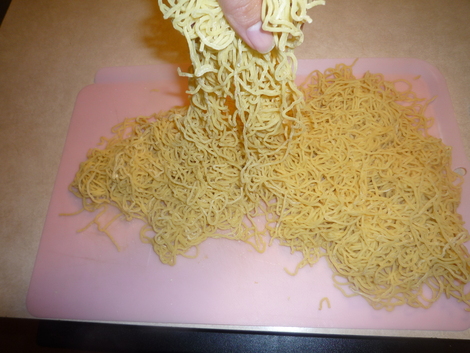
Wash and drain the noodles and then cool with ice cubes.
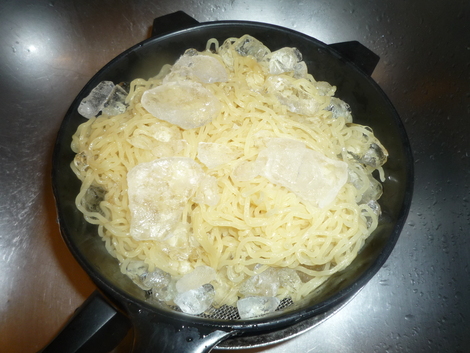
Discard the ice and drain as much water as you can out of the noodles. Push down and use a pointed sieve or colander.
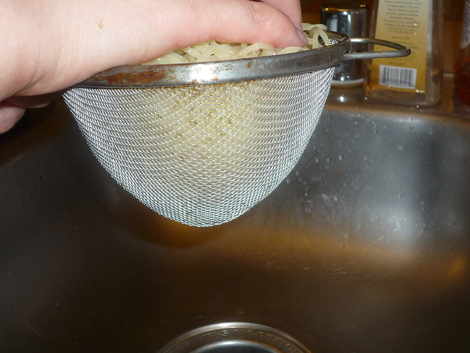
Plate the hiyashi Chuka by arranging all the topping around in a circle.
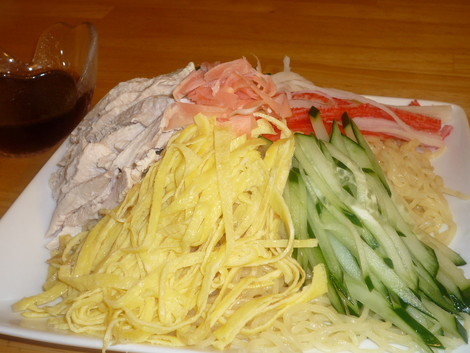

Naomi Kuwabara was born and raised in California but spent many summers in Japan growing up. She has spent time living in Hokkaido and Osaka, both meccas for Japanese cuisine. Her passion is cooking and sharing her experiences cooking Japanese food with others. Her blog Umamitopia is about her experiences cooking Japanese food. Her greatest inspirations are from her mother and grandmother. Her cooking adventures can be found at http://umamitopia.com.


